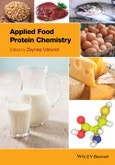Food proteins are of great interest, not only because of their nutritional importance and their functionality in foods, but also for their detrimental effects. Although proteins from milk, meats (including fish and poultry), eggs, cereals, legumes, and oilseeds have been the traditional sources of protein in the human diet, potentially any proteins from a biological source could serve as a food protein. The primary role of protein in the diet is to provide the building materials for the synthesis of muscle and other tissues, and they play a critical role in many biological processes. They are also responsible for food texture, color, and flavor. Today, food proteins are extracted, modified, and incorporated into processed foods to impart specific functional properties. They can also have adverse effects in the diet: proteins, such as walnuts, pecans, almonds, and cashews, soybean, wheat, milk, egg, crustacean, and fish proteins can be powerful allergens for some people.
Applied Food Protein Chemistry is an applied reference which reviews the properties of food proteins and provides in-depth information on important plant and animal proteins consumed around the world. The book is grouped into three sections: (1) overview of food proteins, (2) plant proteins, and (3) animal proteins. Each chapter discusses world production, distribution, utilization, physicochemical properties, and the functional properties of each protein, as well as its food applications. The authors for each of the chapters are carefully selected experts in the field. This book will be a valuable reference tool for those who work on food proteins. It will also be an important text on applied food protein chemistry for upper-level students and graduate students of food science programs.
Table of Contents
About the Editor vii
List of Contributors ix
Scientific Review Panel xiii
Preface xv
Acknowledgments xvii
Part I Protein Properties
1 Introduction to Food Proteins 3
Zeynep Ustunol
2 Overview of Food Proteins 5
Zeynep Ustunol
3 Amino Acids, Peptides, and Proteins 11
Zeynep Ustunol
4 Physical, Chemical, and Processing-Induced Changes in Proteins 23
Zeynep Ustunol
5 Functional Properties of Food Proteins 47
Eleana Kristo and Milena Corredig
6 Biologically Active Peptides from Foods 75
Fereidoon Shahidi and Quanqaun Li
7 Protein and Peptide-Based Antioxidants 99
Roger Nahas and John Weaver
8 Nutritional Aspects of Proteins 113
Nathalie Trottier and Ryan Walker
Part II Plant Proteins
9 Soy Proteins 141
Luis Mojica, Vermont P. Dia, and Elvira Gonz´alez de Mej´ıa
10 Canola/Rapeseed Proteins and Peptides 193
Ayyappan Appukuttan Aachary, Usha Thiyam-Hollander, and Michael N.A. Eskin
11 Wheat Proteins 219
Ang´ela Juh´asz, Frank B´ek´es, and Colin W. Wrigley
12 Rice Proteins 305
Marissa Villafuerte Romero
13 Sorghum and Millet Proteins 323
Scott Bean and Brian P. Ioerger
Part III Animal Proteins
14 Muscle Proteins 363
Iksoon Kang and Pranjal Singh
15 Seafood Proteins and Surimi 393
Jae W. Park and Zachary H. Reed
16 Milk Proteins 427
Nana Y. Farkye and Nagendra Shah
17 Egg Proteins 459
Yoshinori Mine
Index 491








